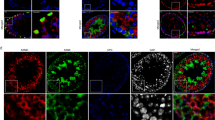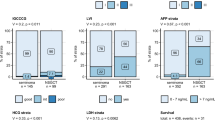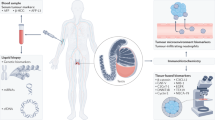Abstract
Background
Testicular germ cell tumours (TGCTs) have a high sensitivity to chemotherapy and a high cure rate, although with serious adverse effects. In the search for tumour suppressive drugs, the RANKL inhibitor Denosumab, used to treat osteoporosis, came up as a candidate since RANKL signalling was recently identified in the testis.
Methods
Expression of RANKL, RANK and OPG, and the effects of RANKL inhibition were investigated in human TGCTs, TGCT-derived cell-lines, and TGCT-xenograft models. Serum RANKL was measured in TGCT-patients.
Results
RANKL, RANK, and OPG were expressed in germ cell neoplasia in situ (GCNIS), TGCTs, and TGCT-derived cell lines. RANKL-inhibition reduced proliferation of seminoma-derived TCam-2 cells, but had no effect on embryonal carcinoma-derived NTera2 cells. Pretreatment with Denosumab did not augment the effect of cisplatin in vitro. However, inhibition of RANKL in vivo reduced tumour growth exclusively in the TCam-2-xenograft model and Denosumab-treatment decreased proliferation in human GCNIS cultures. In TGCT-patients serum RANKL had no prognostic value.
Conclusions
This study shows that the RANKL signalling system is expressed in GCNIS and seminoma where RANKL inhibition suppresses tumour growth in vitro and in vivo. Future studies are needed to determine whether RANKL is important for the malignant transformation or transition from GCNIS to invasive tumours.
This is a preview of subscription content, access via your institution
Access options
Subscribe to this journal
Receive 24 print issues and online access
$259.00 per year
only $10.79 per issue
Buy this article
- Purchase on Springer Link
- Instant access to full article PDF
Prices may be subject to local taxes which are calculated during checkout






Similar content being viewed by others
References
Gurney JK, Florio AA, Znaor A, Ferlay J, Laversanne M, Sarfati D, et al. International Trends in the Incidence of Testicular Cancer: lessons from 35 years and 41 countries. Eur Urol. 2019;76:615–23. https://doi.org/10.1016/j.eururo.2019.07.002.
Feldman DR, Bosl GJ, Sheinfeld J, Motzer RJ. Medical treatment of advanced testicular cancer. JAMA. 2008;299:672–84.
Pliarchopoulou K, Pectasides D. Late complications of chemotherapy in testicular cancer. Cancer Treat Rev. 2010;36:262–7.
Bandak M, Jørgensen N, Juul A, Lauritsen J, Oturai PS, Mortensen J, et al. Leydig cell dysfunction, systemic inflammation and metabolic syndrome in long-term testicular cancer survivors. Eur J Cancer. 2017;84:9–17.
Skakkebaek NE. Possible carcinoma-in-situ of the testis. Lancet. 1972;2:516–7.
Skakkebaek NE, Berthelsen JG, Giwercman A, Müller J. Carcinoma-in-situ of the testis: possible origin from gonocytes and precursor of all types of germ cell tumours except spermatocytoma. Int J Androl. 1987;10:19–28.
Rajpert-De Meyts E. Developmental model for the pathogenesis of testicular carcinoma in situ: genetic and environmental aspects. Hum Reprod Update. 2006;12:303–23.
Moch H, Cubilla AL, Humphrey PA, Reuter VE, Ulbright TM. The 2016 WHO classification of tumours of the urinary system and male genital organs-part a: renal, penile, and testicular tumours. Eur Urol. 2016;70:93–105.
Hoei-Hansen CE, Almstrup K, Nielsen JE, Brask Sonne S, Graem N, Skakkebaek NE, et al. Stem cell pluripotency factor NANOG is expressed in human fetal gonocytes, testicular carcinoma in situ and germ cell tumours. Histopathology. 2005;47:48–56.
Rajpert-De Meyts E, Hanstein R, Jørgensen N, Græm N, Vogt PH, Skakkebæk NE. Developmental expression of POU5F1 (OCT-3/4) in normal and dysgenetic human gonads. Hum Reprod. 2004;19:1338–44.
Sonne SB, Almstrup K, Dalgaard M, Juncker AS, Edsgard D, Ruban L, et al. Analysis of gene expression profiles of microdissected cell populations indicates that testicular carcinoma in situ is an arrested gonocyte. Cancer Res. 2009;69:5241–50.
Rajpert-De Meyts E, McGlynn KA, Okamoto K, Jewett MAS, Bokemeyer C. Testicular germ cell tumours. Lancet. 2016;387:1762–74.
Blomberg Jensen M, Jørgensen A, Nielsen JE, Steinmeyer A, Leffers H, Juul A, et al. Vitamin D metabolism and effects on pluripotency genes and cell differentiation in testicular germ cell tumors in vitro and in vivo. Neoplasia. 2012;14:952–63.
Jacobsen C, Honecker F. Cisplatin resistance in germ cell tumours: models and mechanisms. Andrology. 2015;3:111–21.
Jørgensen A, Blomberg Jensen M, Nielsen JE, Juul A, Rajpert-De Meyts E. Influence of vitamin D on cisplatin sensitivity in testicular germ cell cancer-derived cell lines and in a NTera2 xenograft model. J Steroid Biochem Mol Biol. 2013;136:238–46. https://doi.org/10.1016/j.jsbmb.2012.10.008.
Kearns AE, Khosla S, Kostenuik PJ. Receptor activator of nuclear factor kappaB ligand and osteoprotegerin regulation of bone remodeling in health and disease. Endocr Rev. 2008;29:155–92.
Simonet W, Lacey D, Dunstan C, Kelley M, Chang M-S, Lüthy R, et al. Osteoprotegerin: a novel secreted protein involved in the regulation of bone density. Cell 1997;89:309–19.
Khosla S. Minireview: the OPG/RANKL/RANK system. Endocrinology. 2001;142:5050–5.
Cummings SR, Martin JS, McClung MR, Siris ES, Eastell R, Reid IR, et al. Denosumab for prevention of fractures in postmenopausal women with osteoporosis. N Engl J Med. 2009;361:756–65. https://doi.org/10.1056/NEJMoa0809493.
Bone HG, Wagman RB, Brandi ML, Brown JP, Chapurlat R, Cummings SR, et al. 10 years of denosumab treatment in postmenopausal women with osteoporosis: results from the phase 3 randomised FREEDOM trial and open-label extension. Lancet Diabetes Endocrinol. 2017;5:513–23.
Lipton A, Steger GG, Figueroa J, Alvarado C, Solal-Celigny P, Body J-J, et al. Randomized active-controlled phase II study of denosumab efficacy and safety in patients with breast cancer-related bone metastases. J Clin Oncol. 2007;25:4431–7. https://doi.org/10.1200/JCO.2007.11.8604.
Smith MR, Saad F, Coleman R, Shore N, Fizazi K, Tombal B, et al. Denosumab and bone metastasis-free survival in men with castration-resistant prostate cancer: results of a global phase 3, randomised, placebo-controlled trial. Lancet. 2012;379:39–46.
Chamoux E, Houde N, L’Eriger K, Roux S. Osteoprotegerin decreases human osteoclast apoptosis by inhibiting the TRAIL pathway. J Cell Physiol. 2008;216:536–42.
McKee CM, Ye Y, Richburg JH. Testicular germ cell sensitivity to TRAIL-induced apoptosis is dependent upon p53 expression and is synergistically enhanced by DR5 agonistic antibody treatment. Apoptosis. 2006;11:2237–50.
Ikeda T, Kasai M, Utsuyama M, Hirokawa K. Determination of three isoforms of the receptor activator of nuclear factor-kappaB ligand and their differential expression in bone and thymus. Endocrinoloy. 2001;142:1419–26.
Lum L, Wong BR, Josien R, Becherer JD, Erdjument-Bromage H, Schlöndorff J, et al. Evidence for a role of a tumor necrosis factor-α (TNF-α)-converting enzyme-like protease in shedding of TRANCE, a TNF family member involved in osteoclastogenesis and dendritic cell survival. J Biol Chem. 1999;274:13613–8.
Blomberg Jensen M, Andreassen CH, Jørgensen A, Nielsen JE, Juel Mortensen L, Boisen IM, et al. RANKL regulates male reproductive function. Nat Commun. 2021;12:1–15. https://doi.org/10.1038/s41467-021-22734-8.
Gonzalez-Suarez E, Jacob AP, Jones J, Miller R, Roudier-Meyer MP, Erwert R, et al. RANK ligand mediates progestin-induced mammary epithelial proliferation and carcinogenesis. Nature. 2010;468:103–7.
Li X, Liu Y, Wu B, Dong Z, Wang Y, Lu J, et al. Potential role of the OPG/RANK/RANKL axis in prostate cancer invasion and bone metastasis. Oncol Rep. 2014;32:2605–11.
Mikami S, Katsube KI, Oya M, Ishida M, Kosaka T, Mizuno R, et al. Increased RANKL expression is related to tumour migration and metastasis of renal cell carcinomas. J Pathol. 2009;218:530–9.
Shang WQ, Li H, Liu LB, Chang KK, Yu JJ, Xie F, et al. RANKL/RANK interaction promotes the growth of cervical cancer cells by strengthening the dialogue between cervical cancer cells and regulation of IL-8 secretion. Oncol Rep. 2015;34:3007–16.
Juel Mortensen L, Lorenzen M, Jørgensen N, Andersson A-M, Nielsen JE, Petersen LI, et al. Possible link between FSH and RANKL release from adipocytes in men with impaired gonadal function including Klinefelter syndrome. Bone. 2019;123:103–14. https://doi.org/10.1016/j.bone.2019.03.022.
Jørgensen A, Nielsen JE, Almstrup K, Toft BG, Petersen BL, De Meyts ER. Dysregulation of the mitosis-meiosis switch in testicular carcinoma in situ. J Pathol. 2013;229:588–98.
Fenske AE, Glaesener S, Bokemeyer C, Thomale J, Dahm-Daphi J, Honecker F, et al. Cisplatin resistance induced in germ cell tumour cells is due to reduced susceptibility towards cell death but not to altered DNA damage induction or repair. Cancer Lett. 2012;324:171–8. https://doi.org/10.1016/j.canlet.2012.05.009.
Andrews PW, Gönczöl E, Plotkin SA, Dignazio M, Oosterhuis JW. Differentiation of TERA-2 human embryonal carcinoma cells into neurons and HCMV permissive cells: Induction by agents other than retinoic acid. Differentiation 1986;31:119–26.
Mizuno Y, Gotoh A, Kamidono S, Kitazawa S. Establishment and characterization of a new human testicular germ cell tumor cell line (TCam-2). Nihon Hinyōkika Gakkai zasshi. 1993;84:1211–8.
Dobin A, Davis CA, Schlesinger F, Drenkow J, Zaleski C, Jha S, et al. STAR: Ultrafast universal RNA-seq aligner. Bioinformatics 2013;29:15–21.
Howe KL, Achuthan P, Allen J, Allen J, Alvarez-Jarreta J, Ridwan Amode M, et al. Ensembl 2021. Nucleic Acids Res. 2021;49:D884–91.
Liao Y, Smyth GK, Shi W. The Subread aligner: fast, accurate and scalable read mapping by seed-and-vote. Nucleic Acids Res. 2013;41:e108.
Robinson M, McCarthy D, Smyth G edgeR: a Bioconductor package for differential expression analysis of digital gene expression data. Bioinformatics. 2010;26. https://doi.org/10.1093/bioinformatics/btp616.
Law CW, Chen Y, Shi W, Smyth GK. Voom: Precision weights unlock linear model analysis tools for RNA-seq read counts. Genome Biol. 2014;15:1–17.
Ritchie ME, Phipson B, Wu D, Hu Y, Law CW, Shi W, et al. Limma powers differential expression analyses for RNA-sequencing and microarray studies. Nucleic Acids Res. 2015;43:e47.
Wu D, Smyth GK. Camera: A competitive gene set test accounting for inter-gene correlation. Nucleic Acids Res. 2012;40:1–12.
Wickham H. ggplot2: Elegant Graphics for Data Analysis. Springer-Verlag New York; 2016.
Harpelunde Poulsen K, Nielsen JE, Grønkær Toft B, Joensen UN, Rasmussen LJ, Blomberg Jensen M, et al. Influence of Nodal signalling on pluripotency factor expression, tumour cell proliferation and cisplatin-sensitivity in testicular germ cell tumours. BMC Cancer. 2020;20:349.
Lorenzen M, Nielsen JE, Andreassen CH, Juul A, Toft BG, De Meyts ER, et al. Luteinizing hormone receptor is expressed in testicular germ cell tumors: Possible implications for tumor growth and prognosis. Cancers (Basel) 2020;12:1–15.
Jørgensen A, Young J, Nielsen JE, Joensen UN, Toft BG, Rajpert-De Meyts E, et al. Hanging drop cultures of human testis and testis cancer samples: a model used to investigate activin treatment effects in a preserved niche. Br J Cancer. 2014;110:2604-14.
Swarnkar G, Chen THP, Arra M, Nasir AM, Mbalaviele G, Abu-Amer Y. NUMBL interacts with TAK1, TRAF6 and NEMO to negatively regulate NF-κB signaling during osteoclastogenesis. Sci Rep. 2017;7:1–10. https://doi.org/10.1038/s41598-017-12707-7.
Liang J, Nagahashi M, Kim EY, Harikumar KB, Yamada A, Huang W, et al. Sphingosine-1-phosphate links persistent STAT3 activation, chronic intestinal inflammation, and development of colitis-associated cancer. Cancer Cell. 2013;23:107–20.
Jiang Y, Li J, Li G, Liu S, Lin X, He Y, et al. Osteoprotegerin interacts with syndecan-1 to promote human endometrial stromal decidualization by decreasing Akt phosphorylation. Hum Reprod. 2020;35:2439–53.
Armstrong L, Hughes O, Yung S, Hyslop L, Stewart R, Wappler I, et al. The role of PI3K/AKT, MAPK/ERK and NFkappabeta signalling in the maintenance of human embryonic stem cell pluripotency and viability highlighted by transcriptional profiling and functional analysis. Hum Mol Genet. 2006;15:1894–913.
Lee J, Kim HK, Rho JY, Han YM, Kim J. The human OCT-4 isoforms differ in their ability to confer self-renewal. J Biol Chem. 2006;281:33554–65.
Luo J, Yang Z, Ma Y, Yue Z, Lin H, Qu G, et al. LGR4 is a receptor for RANKL and negatively regulates osteoclast differentiation and bone resorption. Nat Med. 2016;22:539–46. https://doi.org/10.1038/nm.4076.
Yi J, Xiong W, Gong X, Bellister S, Ellis LM, Liu Q. Analysis of LGR4 receptor distribution in human and mouse tissues. PLoS ONE. 2013;8:e78144.
Yu C-Y, Liang G-B, Du P, Liu Y-H. Lgr4 promotes glioma cell proliferation through activation of Wnt signaling. Asian Pac J Cancer Prev. 2013;14:4907–11.
Zhu YB, Xu L, Chen M, Ma HN, Lou F. GPR48 promotes multiple cancer cell proliferation via activation of Wnt signaling. Asian Pac J Cancer Prev 2013;14:4775–8.
Ikebuchi Y, Aoki S, Honma M, Hayashi M, Sugamori Y, Khan M, et al. Coupling of bone resorption and formation by RANKL reverse signalling. Nature. 2018; http://www.nature.com/articles/s41586-018-0482-7.
Steven A, Leisz S, Fussek S, Nowroozizadeh B, Huang J, Branstetter D, et al. Receptor activator of NF-κB (RANK)-mediated induction of metastatic spread and association with poor prognosis in renal cell carcinoma. Urol Oncol. 2018;0:1–10.
Chen L-M, Kuo C-H, Lai T-Y, Lin Y-M, Su C-C, Hsu H-H, et al. RANKL increases migration of human lung cancer cells through intercellular adhesion molecule-1 up-regulation. J Cell Biochem. 2011;112:933–41.
Armstrong AP, Miller RE, Jones JC, Zhang J, Keller ET, Dougall WC. RANKL acts directly on RANK-expressing prostate tumor cells and mediates migration and expression of tumor metastasis genes. Prostate. 2008;68:92–104.
Blomberg Jensen M, Leffers H, Petersen JH, Daugaard G, Skakkebaek NE, Rajpert-De Meyts E. Association of the polymorphism of the CAG repeat in the mitochondrial DNA polymerase gamma gene (POLG) with testicular germ-cell cancer. Ann Oncol. 2008;19:1910–4.
Taylor-Weiner A, Zack T, O’Donnell E, Guerriero JL, Bernard B, Reddy A, et al. Genomic evolution and chemoresistance in germ-cell tumours. Nat [Internet]. 2016;540:114–8. https://doi.org/10.1038/nature20596.
Sinha Hikim AP, Lue Y, Yamamoto CM, Vera Y, Rodriguez S, Yen PH, et al. Key apoptotic pathways for heat-induced programmed germ cell death in the testis. Endocrinology 2003;144:3167–75.
Hase T, Yoshimura R, Matsuyama M, Kawahito Y, Wada S, Tsuchida K, et al. Cyclooxygenase-1 and -2 in human testicular tumours. Eur J Cancer. 2003;39:2043–9.
Jostes S, Nettersheim D, Fellermeyer M, Schneider S, Hafezi F, Honecker F, et al. The bromodomain inhibitor JQ1 triggers growth arrest and apoptosis in testicular germ cell tumours in vitro and in vivo. J Cell Mol Med. 2017;21:1300–14.
Skakkebak NE Testicular dysgenesis syndrome: an increasingly common developmental disorder with environmental aspects. Hum Reprod. 2001;16:972–8. https://academic.oup.com/humrep/article-lookup/doi/10.1093/humrep/16.5.972.
Paduch DA, Hilz S, Grimson A, Schlegel PN, Jedlicka AE, Wright WW. Aberrant gene expression by Sertoli cells in infertile men with Sertoli cell-only syndrome. PLoS ONE. 2019;14:1–27.
Faget J, Contat C, Zangger N, Peters S, Meylan E. RANKL signaling sustains primary tumor growth in genetically engineered mouse models of lung adenocarcinoma. J Thorac Oncol. 2017;13:287–98.
Yoldi G, Pellegrini P, Trinidad EM, Cordero A, Gomez-Miragaya J, Serra-Musach J, et al. RANK Signaling blockade reduces breast cancer recurrence by inducing tumor cell differentiation. Cancer Res. 2016;76:5857–69.
Peters S, Clézardin P, Márquez-Rodas I, Niepel D, Gedye C. The RANK-RANKL axis: an opportunity for drug repurposing in cancer? Clin Transl Oncol. 2019;21:977–91. http://link.springer.com/10.1007/s12094-018-02023-5.
van Dam PA, Verhoeven Y, Jacobs J, Wouters A, Tjalma W, Lardon F, et al. RANK-RANKL Signaling in cancer of the uterine cervix: a review. Int J Mol Sci. 2019;20:1–15.
Oechsle K, Bokemeyer C, Kollmannsberger C, Mayer F, Berger LA, Oing C, et al. Bone metastases in germ cell tumor patients. J Cancer Res Clin Oncol. 2012;138:947–52.
Johnson DE, Appelt G, Samuels ML, Luna M. Metastases from testicular carcinoma Study of 78 autopsied cases. Urology. 1976;8:234–9.
Mueller T, Mueller LP, Luetzkendorf J, Voigt W, Simon H, Schmoll HJ. Loss of Oct-3/4 expression in embryonal carcinoma cells is associated with induction of cisplatin resistance. Tumor Biol. 2006;27:71–83.
Abada PB, Howell SB Cisplatin induces resistance by triggering differentiation of testicular embryonal carcinoma cells. PLoS ONE. 2014;9;e87444.
Acknowledgements
We acknowledge Mie Mechta and Lars Roed Ingerslev and The Single-Cell Omics platform at the Novo Nordisk Foundation Center for Basic Metabolic Research (CBMR) for technical and computational expertise and support. We also wish to thank laboratory technicians Ana Ricci Guarnes-Nielsen and Brian Vendelbo Hansen for excellent technical assistance. We acknowledge the efforts by Carsten L. Buus from Pipeline Biotech, who performed the xenograft experiments.
Funding
Novo Nordisk Fonden (Novo Nordisk Foundation), The Danish Cancer Society, and Candys Foundation.
Author information
Authors and Affiliations
Contributions
Conceived and designed the experiments: MBJ and CHA. Performed the experiments: CHA, JEN, and ML. Analysed the data: CHA, LRI, MBJ, and SKF. Contributed reagents/materials/analysis tools and expertise: BGT, AJØ, LJR, CC, CB, AJ, and SKF. Wrote the manuscript: CHA and MBJ. All authors revised and approved the manuscript.
Corresponding author
Ethics declarations
Competing interests
The authors declare no competing interests.
Ethics approval and consent to participate
Ethical approval was obtained for collection of human testis and serum samples from University Hospital of Copenhagen (Rigshospitalet), Copenhagen, Denmark (H-1-2012-007). Serum samples from infertile men, men with TGTs, men with Leydig cell tumour, and men Sertoli cell only pattern in testis biopsy were obtained after after approval from the regional ethical committee (H-4-2010-138, H-17004362, KF-01-2006-3472). Written and informed consent was obtained for the use of all tissues and serum samples included in the study. Animal experiments were approved prior to the beginning of the study and were conducted by Pipeline Biotech in compliance with the Danish Animal Experiments Inspectorate (license number 2011/561-1956).
Consent to publish
Not applicable.
Additional information
Publisher’s note Springer Nature remains neutral with regard to jurisdictional claims in published maps and institutional affiliations.
Supplementary information
Rights and permissions
About this article
Cite this article
Andreassen, C.H., Lorenzen, M., Nielsen, J.E. et al. RANKL regulates testicular cancer growth and Denosumab treatment has suppressive effects on GCNIS and advanced seminoma. Br J Cancer 127, 408–421 (2022). https://doi.org/10.1038/s41416-022-01810-w
Received:
Revised:
Accepted:
Published:
Issue Date:
DOI: https://doi.org/10.1038/s41416-022-01810-w



